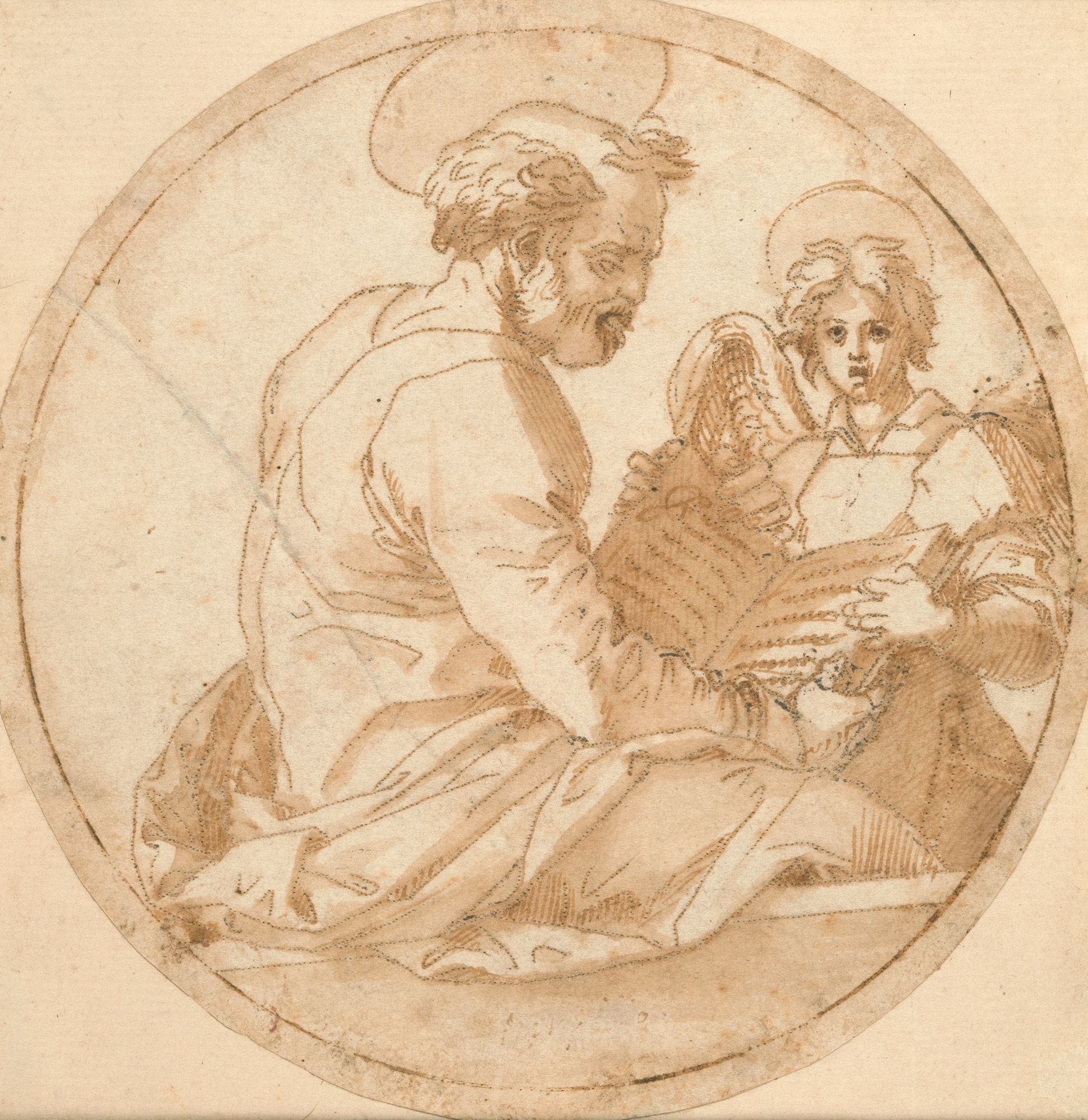FJK 035
Del Sarto Andrea (Andrea d'Agnolo) (Italian, Florence 1486–1530 Florence)
Saint Matthew
ca. 1522-1526
D. 6 37/64 (167 mm)
Medium
Pen, brown ink, brown ink wash and traces of charcoal on paper
Drawing inscribed in a circle and pricked for transfert
Erased inscription below the drapery
Origin
Private Collection
Sale, Christie’s, New York, January 28, 1999, no. 48
Jan Krugier Collection, Monaco, JK 5679
Jan Krugier Foundation
Exhibitions
Berlin, Kupferstichkabinett, Staatliche Museen zu Berlin - Preussischer Kulturbesitz, Linie, Licht und Schatten. Meisterzeichnungen und Skulpturen der Sammlung Jan und Marie-Anne Krugier-Poniatowski, 1999, p. 52, no. 19, color ill. p. 53.
Venice, Peggy Guggenheim Collection, Solomon R. Guggenheim Foundation, The Timeless Eye. Master Drawings from the Jan and Marie-Anne Krugier-Poniatowski Collection, 1999, p. 54, no. 20, color ill. p. 55.
Madrid, Museo Thyssen-Bornemisza, Miradas sin Tiempo. Dibujos, Pinturas y Esculturas de la Coleccion Jan y Marie-Anne Krugier-Poniatowski, 2000, p. 68, no. 19, color ill. p. 69.
Paris, Musée Jacquemart-André, La Passion du dessin. Collection Jan et Marie-Anne Krugier-Poniatowski, 2002, p. 66, no. 22, color ill. p. 67.
Munich, Kunsthalle der Hypo-Kulturstiftung, Das Ewige Auge - Von Rembrandt bis Picasso. Meisterwerke aus der Sammlung Jan Krugier und Marie-Anne Krugier-Poniatowski, 2007, p. 68, no. 26, color ill. p. 69.
Notes
A study for one of the Four Evangelists embroidered on vestments, or paramento, donated by Margherita Passerini on behalf or her son Silvio to the Cathedral of Cortona on 3 November 1526, J. Shearman, Andrea del Sarto, Oxford, 1965, I, p. 249. no. 60.
The paramento is composed of two sections: the altar frontal, or paliotto, with the encircled Madonna and Four Evangelists, and the pluvial with the Transfiguration, all illustrated in S.J. Freedberg, Andrea del Sarto, Cambridge, 1963, fig. 14 and pls. 158-64. The paliotto was, according to the list prepared at the time of the donation, made for the high altar of the Cathedral. It was woven with the coat-of-arms of the Passerini family which included a Cardinal’s hat, that of Silvio, who was appointed Cardinal 1 July 1517. The paramento was used a few years earlier by Pope Leo X when he celebrated a Mass in Cortona on 18 November 1515 at the invitation of Silvio. As John Shearman pointed out, the paramento was executed in two parts, one before 1515 and the other after 1517, probably in the early 1520s. J. Shearman, op. cit., no. 60. The drawings for the embroideries were begun by Raffaellino del Garbo, who died in 1524. Shearman proposed that Sarto began to work on the embroidery before the death of Raffaellino as the distribution of the designs between the two artists appears to have been planned. A date around 1522 is supported by the central medallion of the Madonna, based on the Porta Pinti Madonna (J. Shearman, op. cit., no. 59, pl. 90b) and the central section of a drawing in the Louvre, both datable to that year, D. Cordellier, Hommage à Andrea del Sarto, exhib. cat., Musée du Louvre, Paris, 1986, no. 33. The central figure of the Louvre drawing was encircled after the composition was finished and re-used for the embroidery. Freedberg dates the embroideries to 1525-6. The two medallions with Saints on each side of the paramento are based on designs by Raffaellino del Garbo, S.J.Freedberg, op. cit., I, p. 136 and fig. 14.
Pen drawings for each of the Evangelists are recorded by Shearman, op. cit., pp. 357-9, p. 383, figs. 95a-b. The drawing of Saint Mark, in the same direction as the embroidery, is in the Musée des Beaux Arts, Lille: that of Saint Luke, also in the same direction, is in the Gabinetto Nazionale delle Stampe, Rome: that of Saint John, in reverse to the embroidery, is in the Uffizi and that of Saint Matthew, also in the Uffizi, is in the same direction as the embroidery. The composition of the present drawing and the Uffizi sheet is reversed. The final arrangement of the drawings is Saints Mark and John to the left of the Madonna and Saints Matthew and Luke on Her right, all the saints being lit from the left.
Originally del Sarto had planned to place Saint Matthew on the right and Saint John on the left. The present drawing, along with a red chalk study for the drapery in the Uffizi (6448F. J. Shearman, op. cit., pl. 94a), would have been executed at that stage. At a later point he decided to swap the positions of Saint Matthew and Saint John. For that purpose he executed the reversed drawing of Saint Mathew at the Uffizi to study the play of light on the front drapery of the saint and probably used the recto of the present drawing to transfer the figure on the right of the Madonna. The Saint John was also reversed, as the chalk preliminary study for the drapery (also in the Uffizi, 6447F. J. Shearman, op. cit., pl. 94B) shows the figure sitting on the left side of the Madonna rather than on the right. The sequence of the execution of the compositional drawings in the Uffizi is therefore opposite to that of the corresponding chalk studies: the Saint Matthew was executed after Sarto had decided to swap the figures, while the Saint John was drawn beforehand.
Shearman pointed out that the position of Saint Matthew is the same as that of the Portrait of a man in the National Gallery, London, J. Shearman, op. cit., p. 250 and no. 47.
A double-sided red chalk drawing of the Four Evangelists leaning on a balustrade is in the Getty Museum. N. Turner, European Drawings, 3, Catalogue of the Collection, Los Angeles, 1997, no. 43. That drawing is probably an early idea for the paramento, before Sarto decided to enclose his figure in a circle. The Evangelists are shown full length and without their symbolic beasts.
Christie’s, Important Old Master Drawings, New York January 1999
Request for information/loan
The Jan Krugier Foundation is devoted to increasing the impact of the collection of drawings through regular loans to major exhibitions. Loan applications should include a complete presentation of the project.

